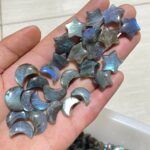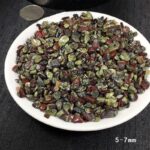Understanding the Mohs Scale
The Mohs scale is a qualitative measure of the scratch resistance of minerals, developed by the German mineralogist Friedrich Mohs in 1822. It provides a standardized scale from 1 to 10, with each level being harder than the previous one.

Moss Agate’s Position on the Scale
Moss agate, a variety of chalcedony, scores between 6.5 to 7 on the Mohs scale. This indicates that it is harder than glass (5.5) but softer than quartz (7).
Softness Considerations
While moss agate is considered relatively hard, it is still susceptible to scratching from harder objects like steel, diamond, and certain kinds of ceramic.
Environmental Factors
The hardness of moss agate can be affected by environmental factors such as exposure to acids, alkalis, and extreme temperatures. Prolonged exposure to harsh conditions can weaken the mineral’s structure, making it more susceptible to scratching.
Applications of Moss Agate’s Hardness
The hardness of moss agate makes it suitable for various applications:
- Jewelry: Moss agate is often used in jewelry making, where its durability and resistance to scratching ensure it can withstand everyday wear.
- Decorative Stones: Its natural beauty and hardness make moss agate a popular choice for decorative stones used in landscaping and architectural elements.
- Industrial Uses: Moss agate’s resistance to scratching and wear enables its use in industrial applications, such as abrasives and polishing agents.
Moss Agate in Different Forms
Moss agate is found in various forms, including:
- Crystals: Moss agate crystals exhibit a distinct botryoidal or grape-like structure, with concentric layers.
- Nodules: Moss agate nodules form round or irregular masses with a hard, outer crust and a more porous interior.
- Tumbled Stones: Tumbled moss agate stones undergo a process of polishing and smoothing, creating smooth, rounded pebbles.
Benefits of Moss Agate’s Hardness
The hardness of moss agate offers several advantages:
- Durability: Moss agate’s resistance to scratching extends its lifespan, making it a durable material for various applications.
- Preservation: Its hardness helps preserve the mineral’s beauty and integrity over time, ensuring it remains an aesthetically pleasing element.
- Versatility: Moss agate’s hardness allows it to be used in a wide range of applications, from jewelry to industrial settings.
Enhancing Moss Agate’s Hardness
While moss agate is naturally hard, certain treatments can enhance its durability further:
- Heat Treatment: Exposing moss agate to heat can strengthen its structure, increasing its scratch resistance.
- Chemical Treatments: Some chemical treatments can alter the mineral’s surface, making it more resistant to scratching.
Table 1: Mohs Scale of Hardness
| Mineral | Mohs Scale Hardness |
|---|---|
| Talc | 1 |
| Gypsum | 2 |
| Calcite | 3 |
| Fluorite | 4 |
| Apatite | 5 |
| Orthoclase Feldspar | 6 |
| Quartz | 7 |
| Topaz | 8 |
| Corundum | 9 |
| Diamond | 10 |
Table 2: Moss Agate Applications Based on Hardness
| Application | Hardness Requirement |
|---|---|
| Jewelry | ≥6.5 |
| Decorative Stones | ≥6.5 |
| Abrasives | ≥7 |
| Polishing Agents | ≥7 |
Table 3: Forms of Moss Agate and Their Hardness
| Form | Mohs Scale Hardness |
|---|---|
| Crystals | 6.5-7 |
| Nodules | 6.5-7 |
| Tumbled Stones | 6.5-7 |
Table 4: Benefits of Moss Agate’s Hardness
| Benefit | Application |
|---|---|
| Durability | Jewelry, decorative stones, industrial uses |
| Preservation | Jewelry, artwork, collections |
| Versatility | Jewelry, landscaping, architecture, industrial |
Creative Applications for Moss Agate
Beyond its traditional uses, moss agate’s hardness opens up possibilities for innovative applications:
- Nanoscale: The durability of moss agate could be utilized in nanoscale applications, such as microfabrication and biomedical devices.
- Abrasives: By combining moss agate with other materials, it could create advanced abrasives with enhanced scratch resistance.
- Polishing: Its scratch resistance and unique texture make moss agate a potential candidate for advanced polishing techniques.




























